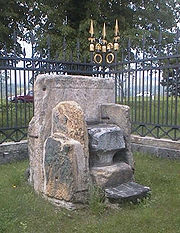
Duke's Chair
Encyclopedia

Maria Saal
Maria Saal is a market town in the district of Klagenfurt-Land in the Austrian state of Carinthia. It is located in the east of the historic Zollfeld plain , the wide valley of the Glan river. The municipality includes the cadastral communes of Kading, Karnburg, Möderndorf, Possau and St...
north of Klagenfurt
Klagenfurt
-Name:Carinthia's eminent linguists Primus Lessiak and Eberhard Kranzmayer assumed that the city's name, which literally translates as "ford of lament" or "ford of complaints", had something to do with the superstitious thought that fateful fairies or demons tend to live around treacherous waters...
in the Austria
Austria
Austria , officially the Republic of Austria , is a landlocked country of roughly 8.4 million people in Central Europe. It is bordered by the Czech Republic and Germany to the north, Slovakia and Hungary to the east, Slovenia and Italy to the south, and Switzerland and Liechtenstein to the...
n state of Carinthia
Carinthia (state)
Carinthia is the southernmost Austrian state or Land. Situated within the Eastern Alps it is chiefly noted for its mountains and lakes.The main language is German. Its regional dialects belong to the Southern Austro-Bavarian group...
.
History
The Duke's Chair, made of RomanAncient Rome
Ancient Rome was a thriving civilization that grew on the Italian Peninsula as early as the 8th century BC. Located along the Mediterranean Sea and centered on the city of Rome, it expanded to one of the largest empires in the ancient world....
gravestones from nearby Virunum
Virunum
Claudium Virunum was a Roman city in the province of Noricum, on today's Zollfeld in the Austrian State of Carinthia. Virunum may also have been the name of the older Celtic-Roman settlement on the hilltop of Magdalensberg nearby....
actually consists of two stone seats, whose backrests are attached to each other. The larger seat, facing to the east, was reserved for the Dukes, the other one, slightly older and facing to the west, for the Counts palatine
Count palatine
Count palatine is a high noble title, used to render several comital styles, in some cases also shortened to Palatine, which can have other meanings as well.-Comes palatinus:...
of the Meinhardiner dynasty.
Together with the Prince's Stone
Prince's Stone
The Prince's Stone is the reversed base of an ancient Ionic column that played an important role in the ceremony surrounding the installation of the princes of Carantania in the Early Middle Ages...
, it played an important role during the installation of the Dukes of Carinthia
Duchy of Carinthia
The Duchy of Carinthia was a duchy located in southern Austria and parts of northern Slovenia. It was separated from the Duchy of Bavaria in 976, then the first newly created Imperial State beside the original German stem duchies....
in a Ceremony that may date back to the Early Medieval principality of Carantania. The chair was first mentioned as sedes Karinthani ducatus on the occasion of the installation of Duke Herman II of Sponheim
Herman II, Duke of Carinthia
Herman II of Sponheim, Duke of Carinthia ruled the Duchy of Carinthia from 1161 to his death. -Family:A scion of the House of Sponheim, he was a son of Margrave Engelbert III of Istria and Matilda of Sulzbach...
in 1161. Here the newly installed duke had to swear an oath
Oath
An oath is either a statement of fact or a promise calling upon something or someone that the oath maker considers sacred, usually God, as a witness to the binding nature of the promise or the truth of the statement of fact. To swear is to take an oath, to make a solemn vow...
in German
German language
German is a West Germanic language, related to and classified alongside English and Dutch. With an estimated 90 – 98 million native speakers, German is one of the world's major languages and is the most widely-spoken first language in the European Union....
and received the homage of the estates
Estates of the realm
The Estates of the realm were the broad social orders of the hierarchically conceived society, recognized in the Middle Ages and Early Modern period in Christian Europe; they are sometimes distinguished as the three estates: the clergy, the nobility, and commoners, and are often referred to by...
. It was the last part of a series of rituals which consisted of the ducal installation on the Prince's Stone (performed in Slovene) and of a mass
Mass (liturgy)
"Mass" is one of the names by which the sacrament of the Eucharist is called in the Roman Catholic Church: others are "Eucharist", the "Lord's Supper", the "Breaking of Bread", the "Eucharistic assembly ", the "memorial of the Lord's Passion and Resurrection", the "Holy Sacrifice", the "Holy and...
, which was held at the church of Maria Saal.
The last installation took place in 1651, though the Duke, Ferdinand of Habsburg, the son of Emperor Ferdinand III
Ferdinand III, Holy Roman Emperor
Ferdinand III was Holy Roman Emperor from 15 February 1637 until his death, as well as King of Hungary and Croatia, King of Bohemia and Archduke of Austria.-Life:...
, did not take part in person, but was represented by a personal deputy.
See also
- Prince's StonePrince's StoneThe Prince's Stone is the reversed base of an ancient Ionic column that played an important role in the ceremony surrounding the installation of the princes of Carantania in the Early Middle Ages...

